For decades, Italy had the West’s largest Communist Party. A key part of the party’s communications to the masses of Italians were its comics, dedicated to resisting the right-wing influence of priests and fascists.
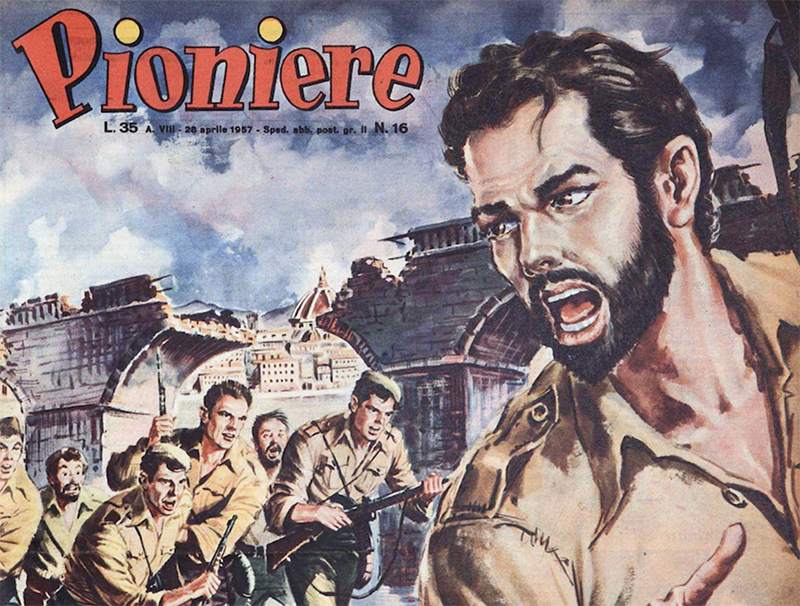
Children’s periodicals have long been a tool of patriotic propaganda, not least during the great military clashes of the twentieth century. In his 1976 study, Claudio Carabba documented how bourgeois Italy’s biggest children’s weekly, Il Corriere dei Piccoli, was long used by first the liberal ruling classes and then the Fascist regime to speak to children. Yet rather less attention has been paid to the use made of similar periodicals by left-wing parties. Standing out among these, in the Italian case, was Il Pioniere, a Communist-inspired children’s comic edited in the 1950s by Dina Rinaldi and Gianni Rodari.
The history of progressive periodicals for children had in fact begun much earlier. As early as 1907, the anarchist Leda Rafanelli published the pamphlet Contro la Scuola (Against School), in which she attacked compulsory education as a bourgeois tool to maintain cultural hegemony over the popular classes by disseminating values of obedience and respect for established authority. Rafanelli invited her comrades to expose the lies of the bourgeoisie by printing books and periodicals which would aim progressive-inspired moral teachings at children.
From then on, a growing number of children’s periodicals were produced, such as Vittorio Podrecca’s monthly illustrated Primavera (Spring) — closed upon the outbreak of World War I — and Italo Toscani’s weekly Il Germoglio (The Seedling). This latter was founded at the end of the war to serve as a link between the children’s circles driven by the Italian Socialist Youth Federation, which sought to promote the “formation of socialist consciousness” through “propaganda readings.”
Il Germoglio soon gave way to Cuore (Heart), printed in Milan by the publisher attached to Avanti!, the Socialist Party’s official daily. It aimed to lift its readers “out of the indifference, the torpor, the quiet life of the satisfied, to make them passionate about a shining idealism, to make them masters of their energies and use them in struggles for the good of their comrades.”
By the time this weekly began coming out in October 1921, the Italian political situation was already severely compromised. The country was already marked by a growing climate of violence, triggered by the “Two Red Years” of strikes and factory occupations and fueled by the advance of fascist squadrism.
The Blackshirts’ march on Rome in October 1922 and torching of the Avanti! headquarters dealt a severe blow to the socialist children’s periodical, which was forced to cease publication in December 1923. For the next twenty years, Italian children would instead be at the mercy of the regime press. Yet, thanks to the Communists, at times there were also clandestine alternatives.
The Communist Press for Children Under Fascism
The encroaching fascist takeover decisively shaped the first appearance of an Italian Communist children’s press. The party had been formed shortly beforehand in January 1921, when most delegates to the Socialists’ Livorno Congress refused to oust the reformists, and the Communist minority led by Amadeo Bordiga instead founded a separate Communist Party.
In July 1922, the new party’s executive committee finished work on Il Fanciullo Proletario (Proletarian Kid), which sought to raise funds for the child victims of the terrible famine that had hit parts of the young Soviet Republic starting in spring 1921, claiming hundreds of thousands of lives. The periodical was very positively received by the children’s clubs attached to the Communist Party, organized along similar lines to circles already run by the Italian Socialist Youth Federation since 1915.
Members clamored for a regular illustrated periodical to act as a link among these children’s clubs, and on September 10, 1922 — just a few weeks before the Fascists’ March on Rome — the first and only issue of Il Fanciullo Proletario was published. Its editor in chief was Nicola Bombacci and its director was Antonio Cassitta, who — according to Paolo Pisu’s biography — had been appointed to head the party children’s organization.
The editorial directly addressed readers, stating that they did not intend to “cloud their minds, like the priests, with frightening visions of hell, nor stuff their skulls with the usual prejudices” taught in schools, but instead to “combat these harmful fruits of bourgeois education, contrasting them with the truthful exposition of facts and social phenomena.”
This “declaration of intent” points to another substantial difference between Il Fanciullo Proletario and earlier socialist periodicals for children, namely the attempt to carry through a real “countereducation.” This aimed at eradicating the many prejudices taught in parish halls and bourgeois schools — as denounced by Rafanelli in 1907 — and at imposing a solid class consciousness in the proletariat from an early age.
This was a time when the party was debating whether or not to form ideologically connotated “schools for proletarian children” as an alternative to a public education system entirely subordinate to ruling-class imperatives. Here, the children’s press became an ideal testing ground for the educational principles developed by a movement which intended to take the politicization of childhood to its furthest consequences by creating a party children’s organization.
The periodical’s markedly ideological framing was also apparent in its particular attitude toward fascism. A few months earlier, in December 1921, the Socialist Cuore had urged its readers to cling to the legs of their older brothers and sisters when they left the house in the evening — making them promise not to take part in clashes with the Fascists. But the Communist periodical instead invited its readers to rebuke and, if necessary, beat up their Fascist contemporaries. This is evident from Luigi Simonetti’s illustrated fable about the adventures of Comunello, Proletino, and Fasciolino, whose eloquent couplets are reproduced below:
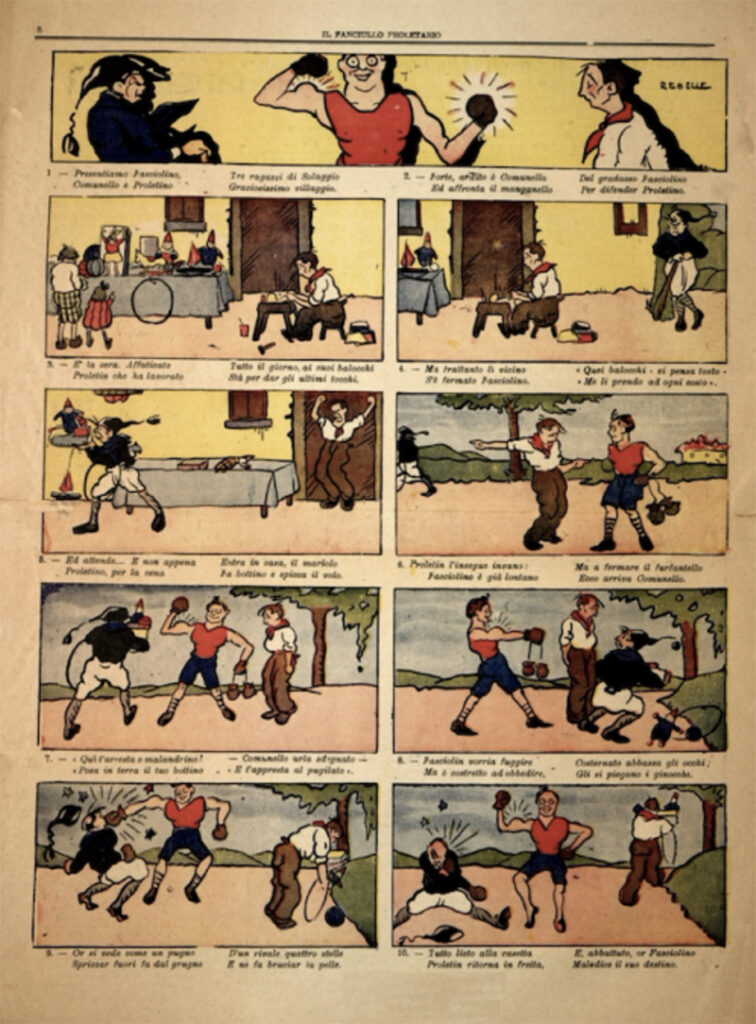
1 – Let’s introduce Fasciolino / Comunello and Proletino / Three boys from Solaggio / a very pretty village. / 2 – Strong and bold is Comunello / and he faces the truncheon / of the boorish Fasciolino / to defend Proletino. / 3 – It’s evening. Exhausted / Proletino, who has worked / all day on his toys / is about to give them their final touches. / 4 – But meanwhile nearby / Fasciolino has stopped. / “Those toys” — he quickly thinks — / “I’ll take them at any cost.” / 5 – And he waits… and as soon as / Proletino enters the house / for dinner, the boy / makes a haul and takes flight… / 6 – Proletino chases him in vain / Fasciolino is already far away / but to stop the little rascal / here comes Comunello. / 7 – “Here, I’ve stopped you, you rascal! / Lay your booty on the ground” / – Comunello shouts indignantly – / “And get ready for boxing.” / 8 – Fasciolino would like to run away / but he is forced to obey, / dismayed he lowers his eyes; / his knees bend under him. / 9 – Now one sees how a fist / shoots four stars out / of a rival’s snout / and burns the skin. / 10 – All happy at the house / Proletino returns in haste, / and, dejected, now Fasciolino / curses his fate.
The characters devised by Luigi Simonetti embodied an entire universe of values: Fasciolino symbolized a brutal Fascist oppression wielding truncheons and castor oil; Proletino represented its victim, the proletariat, exhausted by work and weakened by chronic malnutrition; finally, Comunello portrayed the militant political vanguard of the proletariat, capable — thanks to its more mature class consciousness — of redeeming its class from centuries of oppression and leading it toward revolution.
This was to be the only issue of Il Fanciullo Proletario published before the fall of Italian democracy. The harshening confrontation and the Fascists’ rise to power only a month later forced the Communist Party to concentrate its energies on other fronts. Yet the idea of a children’s magazine did not die.
In January 1927, the Communist Youth Federation’s underground distribution network published a separate edition of Il Fanciullo Proletario — the only example of a clandestine anti-fascist periodical aimed at children. Edited by Gastone Sozzi, its header featured a young pioneer with a red neckerchief. The subtitle was even more explicit: “newspaper for workers’ and peasants’ children.” It was labeled a monthly, but its distribution inevitably depended on the scrupulousness of the Fascist regime’s controls on the clandestine press.
This clandestine periodical again recounted the adventures of Comunello and Proletino, now flanked by Spartachino. The three sought in every possible way to stem the Fascist regime’s overbearing advance into the world of children. They sang the praises of proletarian Russia and revolutionary China, challenged Fascism’s educational and trade union policies, deplored the pacts between the state and the Catholic Church, publicly mocked Mussolini and his hierarchs, distributed leaflets, stirred up the population and tried to get them to revolt against the regime. Sozzi’s little proletarians — like those drawn by Luigi Simonetti — were not ordinary street urchins, but full-blown subversives: their stone throwing was not motivated by recklessness owing to their tender age, but by a precocious class consciousness; theirs were real demonstrative actions, not simple bravado.
The marked politicization of the periodical edited by Sozzi directly reflected the clandestine conditions to which the fascist regime condemned the Communist Party. It had definitively dropped any doubts it may have harbored over the politicization of children — now considered not only appropriate, but inevitable.
For the Communists, every part of the class had to oppose the totalitarian regime with all its might — including children. Anti-capitalism and anti-fascism were the dominant themes: it did not seek to introduce young readers to ideological dogmas, beyond the most very basic level, but rather to make them aware of their subaltern position in society, and incite them to demolish the political and economic system that determined their condition.
The periodical was distributed in Italy’s main factories through the party’s clandestine network and achieved a wide circulation (perhaps in the thousands), even if it was difficult to reach the hands of the small proletarians to whom it was ideally dedicated. The fascist police immediately set to nipping this dangerous instrument of counter-propaganda in the bud. Between June and November 1927, first Enrico Minio and then Sozzi were arrested; and given their centrality to this periodical’s editorial work, it then did not appear throughout the whole of 1928.
The clandestine publication resumed in May 1929 on the initiative of Edoardo D’Onofrio, Pietro Secchia, and Cino Moscatelli, but was again short-lived. The hardening of fascist repression, the progressive thinning of the subversive ranks due to arrests, borders and expatriation, and the growing constraints in which the clandestine cells of the party found themselves operating, made the production of printed material increasingly difficult and its distribution risky.
The last remaining trace of this “newspaper for workers’ and peasants’ children” is an undated leaflet, probably printed in 1930 on a sheet of white tissue paper, at the top of which is a facsimile of the original header. It featured a series of cartoons with a strongly evocative title: “For the children we want bread, or Mussolini’s head.” The protagonists were again Proletino and Comunello:
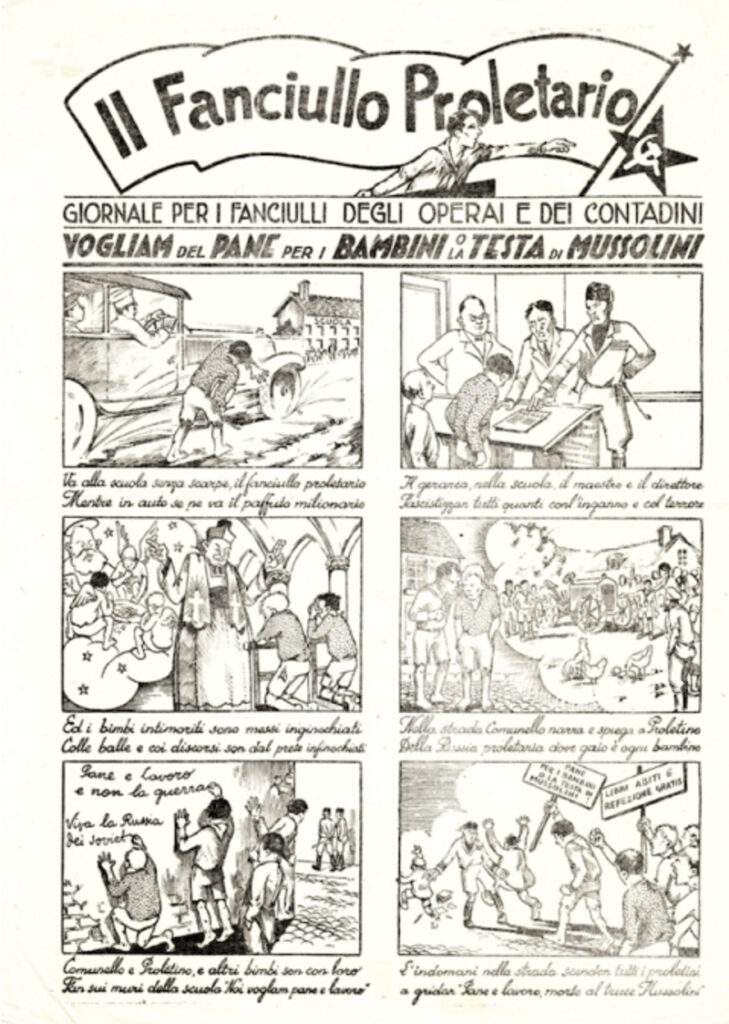
The proletarian kid goes to school with nothing on his feet / while the fat millionaire goes past in his car’s backseat. / The hierarch in the school, the teacher and the boss / they fascistize everyone with terror and dross. / And the frightened children are put on their knees / hoodwinked with lies and speeches from the diocese. / Comunello tells Proletino in the street / of proletarian Russia, where for kids it’s neat. / Comunello and Proletino and every kid with them / write on the school wall “We want bread and work!” / The next day in the street, there’s all the proletini / shouting “Bread and work, death to Mussolini!”
This was the last appearance of the brave Proletino and Comunello. Despite their best efforts they gave way to the obedient Balilla — the model Fascist child whose image the regime would churn out in great abundance in subsequent years.
After Fascism
The Communist Party could only resume its periodicals for children once the regime had been finally overthrown, after 1945. In the meantime, however, an extraordinary revolution had taken place in the field of children’s magazines, with the advent of the comic strip. While avoided by Fascism, which considered it a dangerous cultural by-product of decadent American civilization, this format — which had already arrived in the early 1930s — quickly invaded the pages of all illustrated periodicals for children and became the predominant form of material addressed to them.
This fact was itself an embarrassment to the Communist Party, which strongly criticized US mass culture and the social models and cultural prototypes underlying it. The party’s deep distrust toward this format is attested by the fact that the first comic strip in the Communist milieu, the weekly Noi Ragazzi (Us Guys), was never officially recognized by the party, but created by individual activists. The first issue, published in 1946, featured comic strips created by first-time authors, often with a clear ideological imprint.
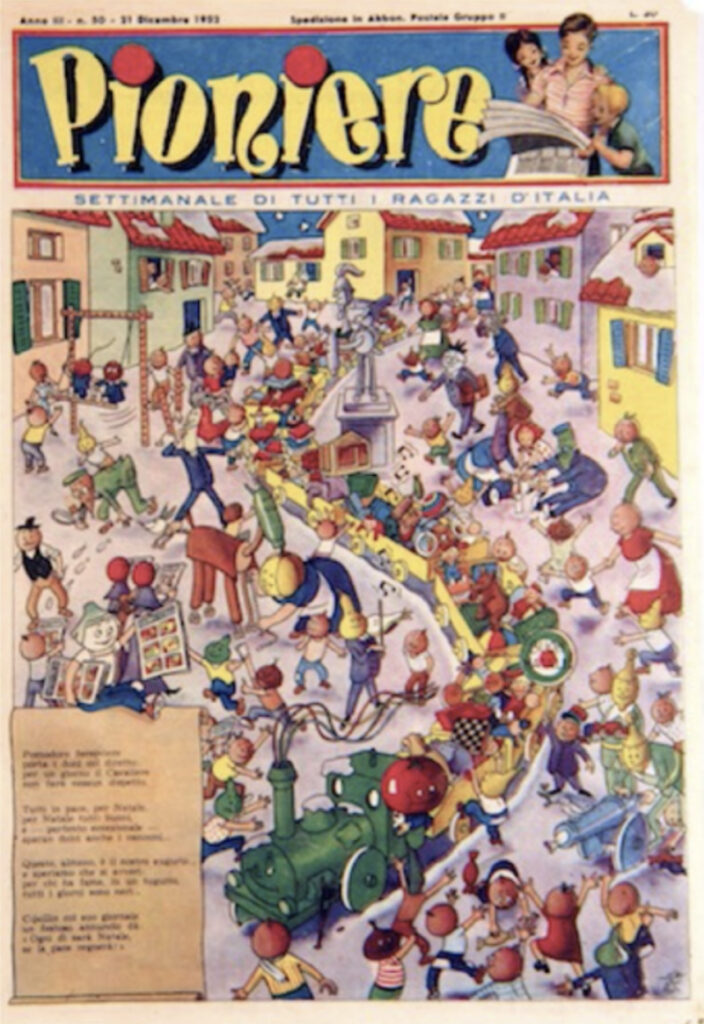
For instance, in 1948 Noi Ragazzi published “The Horseman of Freedom,” depicting the life and adventures of Giuseppe Garibaldi, emblem of the Socialist-Communist People’s Democratic Front in that year’s elections. This was soon followed by photo stories with an ideological imprint. “Captain Mandrin” from 1950 was set in Paris on the eve of the French Revolution and recounted the exploits of the brave captain who, after seeing the suffering of the people, rebelled and went into hiding. Noi Ragazzi also featured “The Young Guard,” a comic strip adaptation of Alexander Fadeyev’s novel; set in the USSR during the Nazi invasion, the photo-novel recounted the tragic exodus of the Russian population to the country’s interior and the beginning of partisan struggle.
The moderate success of Noi Ragazzi and the increasing competition from the Catholic Il Vittorioso — together with the need to provide the youth organization with a modern and competitive press — had also led to significant changes in Communist leaders’ attitude toward comics. In 1950, the decision was made to print and distribute a new children’s magazine with a progressive slant, in opposition to both Catholic and American publications. Noi Ragazzi paid the price for this decision and was ordered to stop publishing to avoid inappropriate overlap with Il Pioniere, the official organ of the Italian Pioneers’ Association (a scout-like group).
The ideals of anti-fascism, democracy, and pacifism immediately became the driving forces behind Il Pioniere. In some periods — coinciding with the escalation of bloc tensions — it had a sharpened anti-American focus and celebration of the USSR. There was never much in terms of anti-Catholic themes, although the heated anti-Communist campaign in 1950s Italy could justify certain more radical responses. Marcello Argilli, at the time its editor, noted that “Il Pioniere never featured a line of atheist or anti-Christian propaganda, nor the slightest hint of disrespect toward the Catholic Church. It was always tacitly secular.”
In a Cold War Italy divided between Communists and Christian-Democrats, Il Pioniere and the Catholic Il Vittorioso carefully avoided directly attacking the opposing party, although they did not shy away from discrediting their respective international referents, i.e. the USSR and the United States. Although clearly ideologically inspired, Il Pioniere was not explicitly political, but rather continually worked to filter a moral and ideal message through its illustrated stories and tales.
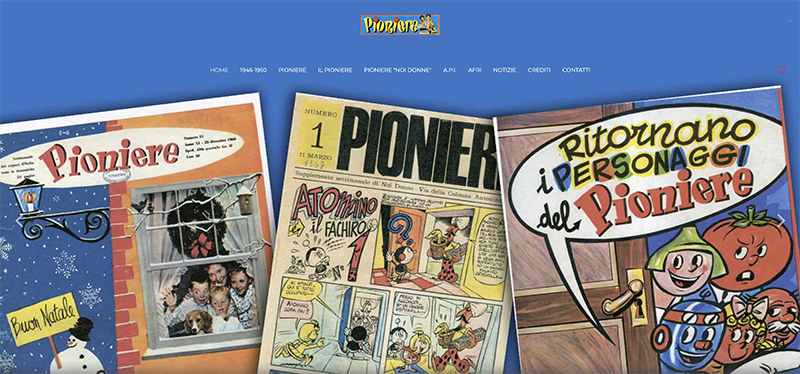
Il Pioniere’s orthodoxy did not, however, shield it from criticism. In the December 1951 issue of the party monthly Rinascita, the MP Nilde Iotti — partner of the Communist Party’s national secretary Palmiro Togliatti — harshly attacked the comic strip. She painted it not only as a product of American mass culture, but also as a threat to the moral, civic and intellectual formation of the new generations. In her view it fostered “repeated illiteracy” and produced a deterioration of the child’s aesthetic senses. Not only the oft-violent content of the comic strips worried Iotti, but also their form:
“It is claimed that the content of the comic strip, not its form, is what makes it dangerous. […] This statement seems to us not only off the mark, but also superficial. […] Content and form are not separable here. Why do comics prefer to, or even exclusively, tell horrifying stories of people who run the gamut of violence and brutality, who are constantly at war with their fellow men, who tend to resolve every conflict with fraud, with a punch to the solar plexus or with a gun, who have no time to nurture feelings, evaluate, reflect? It is the very mode of storytelling that imposes this, because it demands that the protagonists be continuously — with each new frame — engaged in a violent gesture, for the series to maintain its interest.”
Iotti’s rigid stance on comics — based more on general statements than on rigorous arguments — was immediately criticized by the well-known writer Gianni Rodari, who directed Il Pioniere with Dina Rinaldi. Shortly after Iotti’s article was published, Rodari sent a letter to the Rinascita editor expressing his reservations about the theses the Communist MP had advanced in her article. The letter was duly published in January 1952. Rodari stated that he basically shared Iotti’s negative opinion of the American comic strip, but added:
“Iotti, however, extends this negative judgement to comics as a genre, as a way of telling stories, implicitly excluding the possibility of making comics with different forms, contents, spirit and intentions to the American ones. […] A totally negative theoretical judgement is inaccurate, or at least equivocal, and in my opinion Iotti fell into a misunderstanding by polemicizing over the distinction between the form of the comic strip and its content. This distinction . . . is impossible. But Iotti mistook the “form” for the genre, or the medium, or the tool, or whatever we want to call it, represented by the comic strip.”
The coeditor insisted that he did not understand why it was considered illegitimate to tell a story with comics, rather than with our voice, the written word, or cinema. For him, comics were simply a new way of telling stories, which could be good or bad, without affecting their narrative and expressive validity.
According to Rodari, if the party wanted to address young Italians, “it had to take into account the language they are used to, and which has become one of the most important means of communicating with them.” He insisted that Il Pioniere had nothing to do with American comics and strove to produce comics with democratic and progressive content, such as the stories of Cipollino, Chiodino, and Atomino.
Il Pioniere continued to be published regularly until 1966, before it began a phase of decline that ended with its definitive closure in 1970. This was itself a result of a wider crisis in pedagogically inspired press for children, after the end of the “battle for morality” that had marked the era of Italy’s centrist Christian-Democrat-led governments, and the rapid turn in child cultural consumption toward less politically engaged forms of entertainment.
This ended a prolific era in which the Communist Party had attempted, through numerous contradictions, to establish a direct connection with the children of its members and sympathizers.
By Juri Meda
Translation by David Broder
About the author: Juri Meda is associate professor in the history of education at the University of Macerata’s Department of Education, Cultural Heritage, and Tourism.
About the translator: David Broder is Jacobin’s Europe editor and a historian of French and Italian communism.
Article originally published in October 2021 by Jacobin.
Header Image: Home page of ilpioniere.org, promoted by the Comitato Ricerche Associazione Pionieri and coordinated by Carlo Zaia.

























